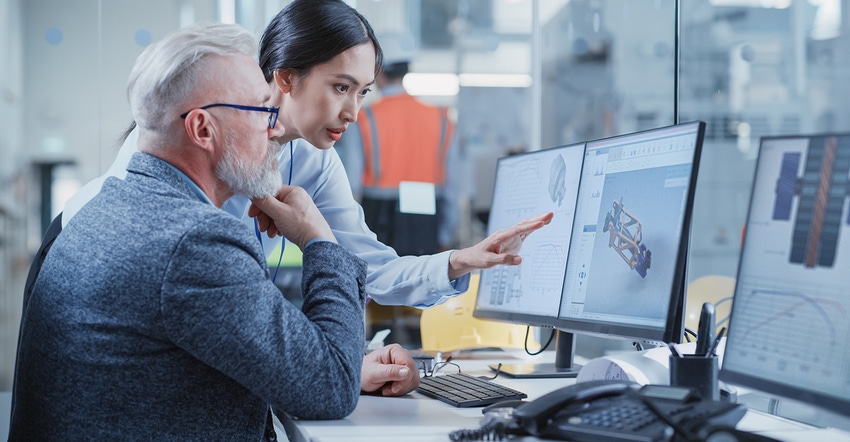Maximizing the Designer-Manufacturer Partnership
A cohesive, single-team approach by design engineers and manufacturers sets the foundation for a successful outcome.
July 13, 2023

Paul K. Steck
Effective collaboration between manufacturers and designers is crucial for achieving design-friendly processes and manufacturing-friendly parts. The partnership sets the foundation for successful outcomes. Let's explore a real-world example to illustrate the significance of this collaboration.
Consider a scenario where a customer has specified a part with multiple colors. As the manufacturer, we assist the designer by incorporating a design technique called a color break or reveal. This involves creating a surface transition where the two colors meet, strategically shadowing certain areas to conceal imperfections and ensuring consistent color alignment. The part dimensions are 0.050 wide by 0.050 in. deep, with a channel where the colors converge. This approach not only hides flaws but also standardizes the color junctions.
Designers are already trained to make their designs manufacturable to a great extent. They typically will develop preliminary designs, request quotes from different manufacturing alternatives, and then reconcile the costs of tooling, production units, and manufacturing methodologies to make an informed decision.
Knowing when to bring in a mold maker is crucial
At Exothermic Molding, we are currently engaged in a similar process with a customer in Georgia. We actively discuss tooling, manufacturing techniques, and identify any design issues or improvements. This process involves a meticulous examination of the designs, encompassing both manufacturing and mold-making considerations. Knowing when to involve a mold maker is crucial and depends on the complexity of the design. Sometimes we can handle it independently, but there are instances where collaborating with a skilled mold maker becomes necessary. In such cases, we engage in conversations with the designer or customer, addressing challenging details. Education plays a significant role in this exchange, as both the designer and manufacturer need to share knowledge and insights about what can be accomplished and how to optimize designs for manufacturing.
Conversely, independent inventors often lack the necessary resources to complete their product development involving multiple parties. However, there are instances where a company possesses both design and manufacturing capabilities in-house, enabling it to undertake the entire process autonomously.
Designers are inherently innovative individuals, continuously exploring new ideas and concepts. To ensure manufacturers stay at the forefront of design innovation, they need to possess a certain level of design expertise. Frequently, designs are received that require modifications to achieve optimal functionality. Therefore, we hire individuals with engineering backgrounds to provide comprehensive recommendations, from prototypes to full-scale production runs.
Molding a solution
Additionally, economic considerations come into play. For example, while 3D printing, aka additive manufacturing, can eliminate the need for molds in certain cases, we recently encountered a situation where a fire-retardant material was required for a specific application. At a certain point, additive pricing becomes prohibitive for production runs, potentially approaching or exceeding the cost of creating a mold. In this instance, the mold manufacturer suggested a solution — constructing the part in two pieces and joining them with screws. This alternative proved successful.
We approached designer Dave La Porta from the LaPorta Design Group to gain insights into improving the designer-manufacturer relationship. Here are his recommendations for both parties.
How can designers enhance collaboration with manufacturers?
"Industrial designers can benefit by bringing in manufacturers early in the product development process to collaborate on the optimal materials and processes for the product and set a target cost for production. Designers need to consider feasibility, strength, and cost. Having a good set of products and manufacturing requirements really help the designer in the ideation phase of the program. Designers need to be as sensitive to cost as engineers. There are several decisions that drive the design process, such as instrument usability, aesthetics, or alignment with corporate visual brand language. Manufacturers need to be aware as early as possible of our design decisions. Otherwise, we run the risk of possible redesign or program setbacks."
How can manufacturers improve collaboration with designers?
"Manufacturers should provide design guidelines for the initial development. Having examples of best practices are helpful. Collaborating with manufacturers early reduces the probability of design revisions and ultimately keeps the R&D program on track. Suppliers who also have prototyping capabilities provide a value-added service and keep them engaged in the program. Another way suppliers can improve the collaboration with designers is to host frequent webinars or write blogs on what’s new in the industry, provide best practices, and improve their exposure with larger corporations."
As new technologies continue to emerge, it is imperative for both designers and manufacturers to stay updated with the latest skills and advancements. The design-manufacturing partnership should seamlessly integrate, transforming into a cohesive, single-team approach. By implementing these strategies and fostering a collaborative environment, manufacturers and designers can work together more effectively, optimizing the design and manufacturing process. Their joint efforts will lead to innovative, cost-effective, and high-quality products that meet customer expectations and drive success in the industry.
|
About the author
Paul K. Steck is the president of Exothermic Molding Inc., a third-generation, family-owned specialty plastics manufacturer in Kenilworth, NJ, serving a variety of verticals including healthcare, laboratory sciences, and defense.
You May Also Like



